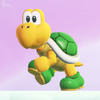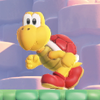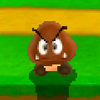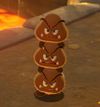|
|
| Line 20: |
Line 20: |
| <blockquote>'''Caveat I - enemies of different colors''': If an enemy subject is differentiated by color in its published name, <u>it warrants receiving a dedicated article only if it is also accompanied by behavioral or mechanical differences, RPG statistics, or comparable attributes that affect gameplay. If color is the only differentiating attribute of the subject, creating a dedicated article for it is discouraged.</u> It would have to appear in a release where it has an accompanying gameplay difference first. (e.g., all [[Biddybud]]s behave the same regardless of color and should not receive their own articles. The same is true for the green Cataquacks on [[Peach Beach]] and the blue Koopa Paratroopas from [[Cloudtop Cruise]].) For colored enemies that do warrant article coverage, appearances of the subject in subsequent games and other genres should be covered in their article as well, as one would for other characters and enemy species. (e.g., the Pink Shy Guy from ''[[Mario Kart Tour]]'' would ontologically be considered the same subject from ''[[Super Mario Bros. 2]]''.) For appearances within the same or similar genres of game, the exact type of behavioral difference between the subject and related enemies of different colors does not have to be the exact same one between different games for it to be considered the same subject. (e.g. the Red Cheep Cheep in ''[[Super Mario Bros.]]'' is the slow-moving variant, whereas the Red Cheep Cheep in ''[[Super Mario Maker]]'' swims quickly and homes-in on Mario. They are still ontologically considered the Red Cheep Cheep and should share an article.) If a long-established enemy subject is designated by the name of a color to distinguish it from a colored variants introduced in a more contemporary game, it should be treated as synonymous with original enemy's name, and not a wholly new subject (i.e. the "Blue Magikoopa" in ''[[Puzzle & Dragons: Super Mario Bros. Edition]]'' should be considered ontologically the same as the normal [[Magikoopa]], and does not warrant an article of its own).</blockquote> | | <blockquote>'''Caveat I - enemies of different colors''': If an enemy subject is differentiated by color in its published name, <u>it warrants receiving a dedicated article only if it is also accompanied by behavioral or mechanical differences, RPG statistics, or comparable attributes that affect gameplay. If color is the only differentiating attribute of the subject, creating a dedicated article for it is discouraged.</u> It would have to appear in a release where it has an accompanying gameplay difference first. (e.g., all [[Biddybud]]s behave the same regardless of color and should not receive their own articles. The same is true for the green Cataquacks on [[Peach Beach]] and the blue Koopa Paratroopas from [[Cloudtop Cruise]].) For colored enemies that do warrant article coverage, appearances of the subject in subsequent games and other genres should be covered in their article as well, as one would for other characters and enemy species. (e.g., the Pink Shy Guy from ''[[Mario Kart Tour]]'' would ontologically be considered the same subject from ''[[Super Mario Bros. 2]]''.) For appearances within the same or similar genres of game, the exact type of behavioral difference between the subject and related enemies of different colors does not have to be the exact same one between different games for it to be considered the same subject. (e.g. the Red Cheep Cheep in ''[[Super Mario Bros.]]'' is the slow-moving variant, whereas the Red Cheep Cheep in ''[[Super Mario Maker]]'' swims quickly and homes-in on Mario. They are still ontologically considered the Red Cheep Cheep and should share an article.) If a long-established enemy subject is designated by the name of a color to distinguish it from a colored variants introduced in a more contemporary game, it should be treated as synonymous with original enemy's name, and not a wholly new subject (i.e. the "Blue Magikoopa" in ''[[Puzzle & Dragons: Super Mario Bros. Edition]]'' should be considered ontologically the same as the normal [[Magikoopa]], and does not warrant an article of its own).</blockquote> |
|
| |
|
| '''Clarification''': This does not mean broader articles for recurring subjects, like those for [[Koopa Troopa]] or [[Shy Guy]], would disappear. As exemplified by the [[Koopa Shell]] article (which coexists with [[Green Shell]], [[Red Shell]], [[Blue Shell]], and [[Gold Shell]] articles) and the [[POW Block]] article (which coexists with [[Red POW Block]] despite normal POW Blocks occasionally being red in older games), rich, thorough, and accurate articles can be written without being in conflict with colored variants. This also does not mean colored variants with mechanical differences that are not recognized as distinct in games or accompanying media cannot receive their own articles if the arguments for them are strong or self evident, as is the case for [[Bubble Dayzee]] or [[Gold Mini Goomba]]. This also does not mean subjects for less recurring colored variants cannot be lumped with each other in one article in the future if it is determined that the information is best kept presented together. Rather, the default assertion should be that if it is recognized as a unique enemy in the game, it warrants an article. The current assumption is that if the enemy is distinguished by its color, it should be lumped with its parent regardless of any other details. We believe this is an unsubstantiated practice: if the red-shelled Koopa Troopa was referred to as the "Timid Koopa Troopa" and all other details about it were exactly the same, it would have received an article of its own long ago. Similarly. subjects like Bull's-Eye Bill would have been lumped with its parent long ago if it was named "Red Bullet Bill." | | '''Clarification''': This does not mean broader articles for recurring subjects, like those for [[Koopa Troopa]] or [[Shy Guy]], would disappear. As exemplified by the [[Koopa Shell]] article (which coexists with [[Green Shell]], [[Red Shell]], [[Blue Shell]], and [[Gold Shell]] articles) and the [[POW Block]] article (which coexists with [[Red POW Block]] despite normal POW Blocks occasionally being red in older games), rich, thorough, and accurate articles can be written without being in conflict with colored variants. This also does not mean colored variants with mechanical differences that are not recognized as distinct in games or accompanying media cannot receive their own articles if the arguments for them are strong or self evident, as is the case for [[Bubble Dayzee]] or [[Gold Mini Goomba]]. This also does not mean subjects for less recurring colored variants cannot be lumped with each other in one article in the future if it is determined that the information is best kept presented together. Rather, the default assertion should be that if it is recognized as a unique enemy in the game, it warrants an article. The current assumption is that if the enemy is distinguished by its color, it should be lumped with its parent regardless of any other details. We believe this is an unsubstantiated practice: if the red-shelled Koopa Troopa was referred to as the "Timid Koopa Troopa" and all other details about it were exactly the same, it would have received an article of its own long ago. Similarly, subjects like Bull's-Eye Bill would have been lumped with its parent long ago if it was named "Red Bullet Bill." |
|
| |
|
| ;affected enemies | | ;affected enemies |
Latest revision as of 03:21, February 20, 2025
tissue
This passing of this proposal would lead to the creation of explicit guidelines for enemy coverage on the Super Mario Wiki with an accompanying MarioWiki:Enemies policy page. It would substantiate most of the enemies that already have their own articles and general editorial trends. It would also allow clarify that one can create articles for named colored variants that have accompanying behavior differences (e.g. Green Koopa Troopa and Red Koopa Troopa), as well as explicitly named behavioral variants (e.g. Sky Blooper and Wonder Bulrush herd). We currently have inconsistent coverage of both. In the future, if a proposal is to pass that goes against the overall policies outlined here, they would be added to the bottom of the MarioWiki:Enemies page, the same way one would archive a proposal, so we do not lose track of anything going forward and readers are provided an easily accessible reference.
This proposal was born from the this discussion on the White Shy Guy article, as well as a long-incubating impression that the way we decide which enemy subjects receive articles and which do not: (1) puts us as odds with the source material we earnestly try to cover; (2) makes our game category pages fragmented and less useful, and sometimes incongruent with the actual game articles; (3) artificially inflates the importance of RPGs over other genres like platformers (i.e. see Red Magikoopa, Sky-Blue Spiny, Green Fuzzy, etc.); (4) has lead to incongruent series of decisions that would not make sense to readers, where enemy A gets split, but enemy B remains merged, even with the criteria for both being the same; and (5) makes it unintuitive to folks who want to contribute to our site.
Nintendo101 specifically relays the following on the White Shy Guy page that captures the apparent inconsistencies:
I think my fellow editors sometimes overlook the fact that the people who create Super Mario games are often utilitarian in design philosophy - they very rarely change the colors of any enemies at all unless there are accompanying behavioral differences, so it is almost never a purely cosmetic decision. We have been making the decision to keep different colored enemies housed in one article in spite of the games and their accompanying media not doing that themselves, which often explicitly list them as separate enemies too in their bestiaries. (This is not always done, as in How to win at Super Mario Bros., for example, but subjects are typically listed as separate far more often then not.) I clarify this because, to me at least, it has never felt particularly clear what the substantive reason why we lump different colored enemies into one article when the games don't, and overtime it has lead to unclear decisions. Is a Koopa Troopa being large but visually identical to its smaller counterpart a more substantive mechanical difference than being a different color and turning at the edge? Because that is the whole reason why Goombrat exists - to be the "Red Koopa Troopa" to Goombas. Why does the Gold Bullet Bill get an article, but not the purple and blue ones from Super Mario Sunshine? Why do subjects like the blue Bowser and Bowser X (the latter of which seems to even be the same person as Bowser) get separate articles, but not the Black Dino Piranha or pink Hisstocrat? Why can't the Red Koopa Troopa, which is immediately perceivably different from the green ones regardless of where it shows up in the wiki and has largely been listed as a different enemy from its green counterpart since 1985, not warrant a dedicated article but the Red Shell does? Is it because they are the same "species" as the Green Koopa Troopa? Then why does Rolla Koopa and Gold Koopa get articles of their own? Why on earth would we support having an all-encompassing Black Shy Guy article, but not one for White Shy Guys? Where can I see a list that tells me where just the white ones show-up throughout the franchise's history? Why can't I have that? There are a bunch of little reasons that answer different parts of these questions, a proposal here, an RPG-specific policy there, but I find none of them particularly satisfying, especially in aggregation and for how it impacts collective coverage of enemies in the Super Mario franchise. And I say this as someone who has integrated a lot of the enemy charts for the mainline games on this wiki. I don't envy a more casual reader trying to make sense of all these naked inconsistencies themselves. The best taxonomic systems are the ones that don't beg scrutiny.
We believe clarification on enemy coverage is long overdo, especially as more users have joined the site. We propose the following policy with two caveats:
Different enemies warrant having their own articles. If the games and their accompanying paratexts (i.e., in-game bestiaries, instruction booklets, officially-licensed guidebooks, encyclopedias, Mario Portal, and other such sources) recognize similar subjects as different types of enemies, even if perceivably or explicitly members of the same species, they warrant having dedicated articles. If a discrepancy exists between sources from different regions, deference should be directed towards ones from the region where the game was developed.
xylem
Top row: Green Koopa Troopa and Red Koopa Troopas (which do not have articles).
Bottom row: Winged Strollin' Stu and Swipin' Stu (which do have articles).
Caveat I - enemies of different colors: If an enemy subject is differentiated by color in its published name, it warrants receiving a dedicated article only if it is also accompanied by behavioral or mechanical differences, RPG statistics, or comparable attributes that affect gameplay. If color is the only differentiating attribute of the subject, creating a dedicated article for it is discouraged. It would have to appear in a release where it has an accompanying gameplay difference first. (e.g., all Biddybuds behave the same regardless of color and should not receive their own articles. The same is true for the green Cataquacks on Peach Beach and the blue Koopa Paratroopas from Cloudtop Cruise.) For colored enemies that do warrant article coverage, appearances of the subject in subsequent games and other genres should be covered in their article as well, as one would for other characters and enemy species. (e.g., the Pink Shy Guy from Mario Kart Tour would ontologically be considered the same subject from Super Mario Bros. 2.) For appearances within the same or similar genres of game, the exact type of behavioral difference between the subject and related enemies of different colors does not have to be the exact same one between different games for it to be considered the same subject. (e.g. the Red Cheep Cheep in Super Mario Bros. is the slow-moving variant, whereas the Red Cheep Cheep in Super Mario Maker swims quickly and homes-in on Mario. They are still ontologically considered the Red Cheep Cheep and should share an article.) If a long-established enemy subject is designated by the name of a color to distinguish it from a colored variants introduced in a more contemporary game, it should be treated as synonymous with original enemy's name, and not a wholly new subject (i.e. the "Blue Magikoopa" in Puzzle & Dragons: Super Mario Bros. Edition should be considered ontologically the same as the normal Magikoopa, and does not warrant an article of its own).
Clarification: This does not mean broader articles for recurring subjects, like those for Koopa Troopa or Shy Guy, would disappear. As exemplified by the Koopa Shell article (which coexists with Green Shell, Red Shell, Blue Shell, and Gold Shell articles) and the POW Block article (which coexists with Red POW Block despite normal POW Blocks occasionally being red in older games), rich, thorough, and accurate articles can be written without being in conflict with colored variants. This also does not mean colored variants with mechanical differences that are not recognized as distinct in games or accompanying media cannot receive their own articles if the arguments for them are strong or self evident, as is the case for Bubble Dayzee or Gold Mini Goomba. This also does not mean subjects for less recurring colored variants cannot be lumped with each other in one article in the future if it is determined that the information is best kept presented together. Rather, the default assertion should be that if it is recognized as a unique enemy in the game, it warrants an article. The current assumption is that if the enemy is distinguished by its color, it should be lumped with its parent regardless of any other details. We believe this is an unsubstantiated practice: if the red-shelled Koopa Troopa was referred to as the "Timid Koopa Troopa" and all other details about it were exactly the same, it would have received an article of its own long ago. Similarly, subjects like Bull's-Eye Bill would have been lumped with its parent long ago if it was named "Red Bullet Bill."
- affected enemies
- Koopa Troopas
- Green Koopa Troopa: SMB, TLL, SMB3, SMW, SMAS, SMBD, SMA2, SMA4, NSMB, SMG, NSMBW, SMG2, NSMB2, NSMBU, NSLU, SMM, P&D, SMR, SMO, SMM2, SMBW
- Red Koopa Troopa: SMB, TLL, SMB3, SMW, SMAS, SMBD, SMA2, SMA4, NSMB, SMG, NSMBW, NSMB2, NSMBU, NSLU, SMM, P&D, SMR, SMO, SMM2, SMBW
- Blue Koopa Troopa: SMW, SMA2, NSMB, SMO
- Yellow Koopa Troopa: SMW, SMA2, P&D
- Gold Koopa: NSMB2, SMO
- Koopa Paratroopas
- Green Koopa Paratroopa: SMB, TLL, SMB3, SMW, SMAS, SMBD, SMA2, SMA4, NSMB, NSMBW, NSMB2, NSMBU, NSLU, SMM, SMM2, SMBW
- Red Koopa Paratroopa: SMB, TLL, SMB3, SMW, SMAS, SMBD, SMA2, SMA4, NSMB, NSMBW, NSMB2, NSMBU, NSLU, SMM, SMR, SMM2, SMBW
- Yellow Koopa Paratroopa: SMW, SMA2, P&D
- Gold Koopa Paratroopa: NSMB2
- Big Koopa Troopas
- Big Koopa Paratroopas
- Climbing Koopas
- Electro-Koopas
- Hammer Bros.
- Lakitus
- Spiny Eggs
- Spike Tops
- Magikoopas
- Bowsers
- Goombas
- Goomba Towers
- Paragoombas
- Cheep Cheeps
- Red Cheep Cheep: SMB, TLL, SMB3, SMAS, SMBD, SMA4, SMM, SMM2
- Gray Cheep Cheep: SMB, TLL
- Green Cheep Cheep: SMB3, SMAS, SMBD, SMA4, SMM, SMM2
- Gold Cheep Cheep: NSMB2
- Piranha Plants
- Big Piranha Plants
- Dino Piranhas
- Bullet Bills
- Bomber Bills
- Lava Bubbles
- Shy Guys
- Mega Guys
- Snifits
- Beezos
- Pansers
- Birdos
- Boos
- Big Boos
- Winged Strollin' Stus
- Cataquacks
- Crabbers
- Chomps
- King Kalientes
- Gobbleguts
- Coin Coffers
- King Coin Coffers
- Hisstocrats
- Draggadons
- Trompettes
- Pokipedes
- Gamboos
- Metal Gamboos
- Sugarstars
- Konks
- Bloomps
phloem
Goomba and Goomba Tower (which have their own articles).
Caveat II - enemies of different behaviors: If a subject is differentiated by its behavior in its published name, they also warrant receiving their own article, but only times when the subject goes by the same (or a similar) name as the subject does in its attributed debut. This is because some recurring enemies inherited the behaviors of their variants in future appearances, but Nintendo still recognizes the original variant as distinct when they discuss the original releases. If a subject with a distinct behavior is not differentiated from its parent in name, they are assumed to be the same subject and dedicated article coverage is discouraged.
- affected enemies
- Bloopers
- Blooper Nannies
- Ninjis
- Buzzy Beetles
- Spinys
- Bullet Bills
- Bomber Bills
- Missile Megs
- Piranha Plants
- Boos
- Cheep Cheeps
- Undergrunt Gunners
- Chomps
- Goombas
- Shovas
- Bulrushes
- Blewbirds
- Hoppycats
- Anglefishes
- Gnawshers
Relevant proposals
Main
Talk





